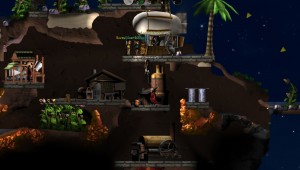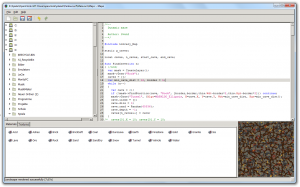OpenClonk 7 released
Posted in Announcements on January 15th, 2016 by Newton – 2 CommentsAnother year passed, and here is another release, version 7!
Though, this year’s version is quite special because it so much larger than the previous updates. The new release is focused on making the game more playable, better looking and giving it an overall nicer athmosphere: New controls, new GUI, more ambience, life, game content and bazillion of bugfixes.
Previously I wrote about the Milestone Project and I am safe to say that without the people that organized themself in this project, version 7 wouldn’t be half as extensive or awesome as it has become because not only did they make the game more beautiful and added a good deal of new game content, they also provided everyone else with a huge motivational boost with their organized effort – core developers and occasional contributors alike.
Let me use this oppurtunity to thank all the many people who did their part in the Milestone Project and still are, especially David Oerther (ala), Martin Adam (Win), Armin Schäfer and Florian Graier (Nachtfalter).
Let’s look forward to the next milestones, which are already in planning. Check them out, especially if you are interested to contribute something in the future (German content): Milestone #2, Milestone #3.
And now, for the long list of major enhancements done for this version:
New Controls and GUI
- By initiative from David Dormagen (Zapper), OpenClonk has new controls again. The biggest change is a switch from two usable items (one on each mouse button) to just one while freeing the other mouse button. See above for more details.
- Again by initiative from David Dormagen, the whole ingame GUI has been remade. Script creation of GUI elements and menus is not only easier but a lot more flexible. Also, these GUI elements run asynchronously among clients, freeing network capacities. For more information, check the documentation. Based on this system, Felix Wagner (Clonkonaut) streamlined the ingame HUD. For a detailed description, have a look at the feedback thread.
- Fitting to the new control scheme, Maikel created completely new tutorial scenarios. The idea is that the players are slowly led into “normal” missions rather than having just a few “learning rounds” and that’s it. Please mind that not all tutorials are finished yet but the very basic ones are.
More Ambience
- David Oerther (ala) composed a completely new soundtrack. For licensing reason, it is not included in the default OpenClonk download but the Windows installer will ask you whether it should be automatically downloaded. Others can get it from the download page. Furthermore, songs have been added to the included soundtrack by Martin Strohmeier (K-Pone).
- To celebrate the new soundtrack, Sven2 implemented an ambient music system which tries to play the fitting music depending on your situation and surroundings in the game. Speaking of sound, Sven2 also extended the sound system to be able to add effects such as reverb, echo or pitch to sound effects. For example, now every sound in a cave has a little echo and underwater, all sounds are damped.
- Also greatly adding to the ambience in the game are the huge amount of new sound effects that have been added to the game, mainly from David Oerther (ala). After all, the more sound effects there are, the more noise you can make in caves and underwater. A cumulative bonus.
- Thanks to the initiative from several people from the Milestone project, most notably Matthias Rottländer and Florian Graier (Nachtfalter), almost all material textures were recreated. This has a huge impact on the visuals of the game, giving Open Clonk a whole new and tidy look. All materials got normal maps, which makes the landscape appear quite three-dimensional!
- The dynamic lighting system that had been introduced in version 6 has been greatly enhanced. Most notably are the addition of colored lights by Mark Haßelbusch, more usage of shaders (glowing lava, shiny gold, …), more usage of ambient light (i.e. for day-night cycle) and making it easier to implement custom shaders. Armin Burgmeier (Clonk-Karl) and Peter Wortmann were the masterminds in this. The Clonk is now also not the only source of light, but we have torches and lanterns now – plus certain objects add colored lights for effects, i.e. the teleglove.
More Life
- Plant life! There are more trees now than the one coniferous tree we had for a long time, there are flowers, ferns, mushrooms, seaweed, … . This is a big contrast to the otherwise quite brown world of OpenClonk (what can we do? Earth is brown!) and adds big time to a nicer ambience. There are not only decorative plants but also plants like “cotton” and wheat that can be crafted into useful things! All covered in this blog article about farming.
- Animal life! It was time to repopulate the world of Clonk with some wildlife, and hell we did a thorough job with that – the Zaps and the Chippies from Clonk Rage made it back into the game. And of course, our dearest furry friend, the Wipf, is back! But there is much more now – bats, moskitos, fireflies, piranhas, squids, other fishes, a “puka” and more. And, there is more in the pipeline! Both the animal and plant life is mainly thanks to the initiative from the people from the Milestone project again, but in the end most of our content developers were involved.
More Stuff
- There are some noteworthy changes on the workings on the landscape which might be especially interesting for developers: First, Armin Burgmeier (Clonk-Karl) made it freely definable by scenario authors what should be “behind” a material after it has been mined. This opens up some interesting possibilities. Also, Julius Michaelis (JCaesar) added the possibility for platforms – things you can jump through from below but stand on from above. Best example: the airship.
- A lot of new objects, such as the Wooden Bridge (known to players from Clonk Rage), placeable Rope Bridges (those had been in the game for a long time but were not usable by players)
- New scenarios, also a lot of the old scenarios came to know some attention. A new scenario folder was created, including two Defense type scenarios where one has to fend off numerous waves of attackers.
Bazillion Bugfixes
- So many bugfixes and improvements that we honestly lost track. And really everyone was involved. To put this into perspective: For version 7, alone through the bugtracker almost 400 bugs were resolved, that’s more than for version 5 and 6 together!
That’s it.
What’s next?
We will continue work with the organization form of the Milestone Project. There are new creatures waiting to be incorporated into the game, to enliven the scenarios. We want to explore improving deep sea gameplay and the Heavy Resources concept.



